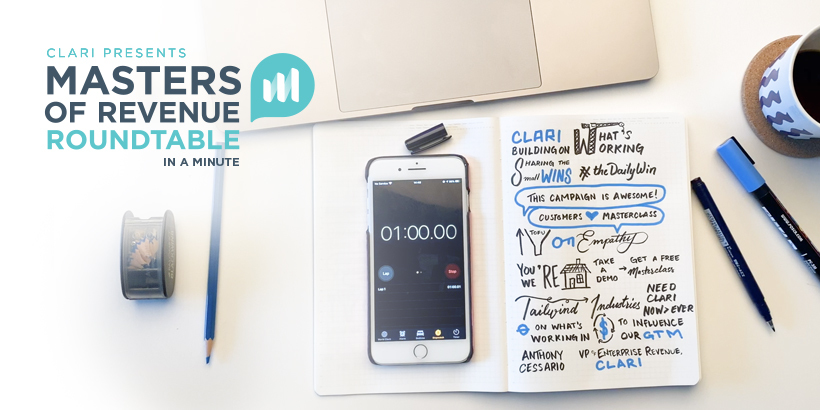No matter what department you work in, remote life certainly has its challenges. And the biggest hurdle for most folks? Maintaining focus. You’ve got your pets, your kids, that pile of dishes you didn’t wash last night, and it’s distracting!
If you work in sales, navigating all of the changes in your pipeline caused by COVID is likely just as overwhelming as trying to juggle that WFH balance and for most, it’s hard to know where to put your energy and attention.
So, we decided to discuss pipeline prioritization in our recent Masters of Revenue Roundtable led by Clari’s VP of Enterprise Revenue, Anthony Cessario. If you missed it, here’s a little sampling of the discussion:
Driving Action by Asking the Right Pipeline Questions
Rubrik’s Vice President of Sales, Austin Stefani, joined Cessario to discuss the key challenges on everyone’s minds:
- How should we be looking at pipeline today?
- How can we focus on the right activities in the right deals?
- How do we hold one another accountable for our sales goals?
Stefani gave some compelling insights about how to reach sales velocity through strategic pipeline segmentation. And he should know. He took his company from a $1 million run rate to $600 million in under two and a half years.Here are some of his best tips:
Assessing Risky Deals
The first step to focusing your sales efforts is assessing risk in each deal to learn which of your prospects are most likely to close during the current quarter.
Long before COVID struck, Stefani began segmenting Rubrik’s pipeline to rapidly scale. “We manage business velocity by going through: what’s the update from last week, what’s the risk in the deal so we can de-risk it, and then what’s the next step,” Stefani said.
Those “next steps” will be captured and used as starting points for the following week’s meeting. Ultimately, this helps reduce overall sales pipeline risk.
Now that the sales environment looks a bit different, Rubrik has implemented a specialized plan for “COVID Risk.” Stefani suggests putting prospects into these buckets:
- Accelerated. This grouping is for companies whose products are in high demand because of the current environment.
- Low Risk. Companies that have not been impacted by COVID and are operating “business as usual” fall into the “low risk” pile.
- Medium Risk. These businesses are not impacted by COVID, per se, but their processes are in flux as they navigate the new digital environment.
- High Risk. When businesses have taken a financial hit and process risk, they are labeled “high risk.”
Stefani highlighted the importance of validating potential risks with the prospects by actually calling them and confirming, rather than relying on the sales rep’s best guess. “That’s given us a better view in the forecast and where to focus,” he said.
Avoiding Panic Selling
During the discussion, some leaders voiced their concern that sales reps are giving in to knee jerk reactions based on fear: They are nervous that a deal won’t close, so they give away too much.
The best way to stop this from happening, according to Stefani, is to provide forums for real-time education. “I run a weekly call with my team and it is all about best practice sharing of positives we see in pipeline generation, creative deals, and breaking down different parts of deal stages, so that people can cross-pollinate,” he said.
It is important that teams have an outlet to share their feelings and understand that others are going through difficulties. Doing so allows for empathy and support, but also drives accountability.
According to Stefani, “Giving people tools to be successful kind of takes the excuses out of their minds because they see that other people having success in similar scenarios, so we just keep feeding them best practices.”
For example, it was noted that early stage pipeline is slowing down because new prospects aren’t invested in change yet. So, Stefani is leading trainings about how to generate early-stage pipeline in a digital world.
Cessario echoed the importance of communicating best practices. “We rolled out a Slack channel called #TheDailyWin where people are commenting on things that are working,” he said. “Focusing on the tailwind industries and sharing the successful activities on those sales cycles has been really helpful.”
Get Close to Customers Early
B2B sales leaders across the board have stressed the importance of delivering even more value to current customers to both reduce churn and even increase the opportunities for early renewals or expanded partnerships. Getting creative with customer care is an absolute must, says Stefani.
Almost everyone’s life has extra complications in this new environment — and it’s given us all a sort of shared experience. Rubrik took that into account and leaned into it. Sales reps flexed their empathy and creativity by sending GrubHub certificates for their prospects to “have a picnic” and sent gaming systems to those with kids that might be bored at home.
“People really leaned into this idea of creatively solving problems at velocity,” said Stefani. “And people are really stepping up.”
Join the Masters of Revenue
Masters of Revenue will be addressing more pressing topics in the weeks ahead and we’d love for you to join the conversation. If you’d like to attend, please email Mayra Delgado at mayra@clari.com and Nick Bennett at nick@clari.com. And as always, please stay safe, stay focused, and stay connected!



